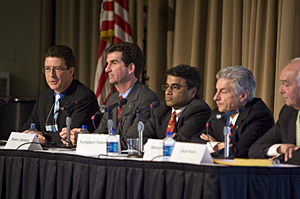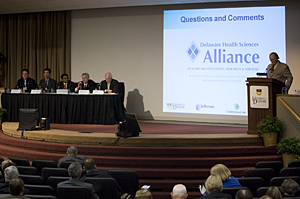
4 p.m., March 25, 2009----Implementing the goals of providing first-class heath research and service as identified in the new Delaware Health Sciences Alliance was the subject of a panel discussion during the “Stronger Health-Based Partnerships” conference, held Tuesday, March 24, in Clayton Hall.
The discussion, moderated by Brian Little, vice president of academic affairs and research for the Christiana Care Health System, followed the formal announcement of the alliance during an earlier panel and an opening keynote address by Delaware Gov. Jack Markell.
The Delaware Health Sciences Alliance is a new partnership of Christiana Care, Nemours, Thomas Jefferson University and the University of Delaware to provide leadership in health and health services.
Little noted that the educators and health care professionals in the alliance have recognized for some time the looming shortage of health professionals and the need for industry and higher education development in the life sciences.
The alliance also represents an opportunity to bring Delaware onto the national stage in biomedical research and education, Little said.
Panel member David L. Paskin, senior associate dean of graduate medical education at Thomas Jefferson University, outlined initiatives including the Delaware Institute of Medical Education and Research, the Medical Scholars Program and preference given to Delaware students applying to medical school at Jefferson.
Ayyappan Rajasekaran, director of the Nemours Center for Childhood Cancer Research, discussed the importance of translational research in improving bench-to-beside health care delivery.
Research initiatives include molecular and cellular studies in signaling networks, biomarkers, drug development and bioinformatics, with hospitals participating in biobanking, clinical trials, validation and epidemiology efforts, Rajasekaran said.
An example of translational research that led to a major discovery is Papanicolaou's Smear (PAP smear), named for its inventor, Dr. G.N. Papanicolaou of Cornell University Medical College, in New York City.
“This is one of the greatest medical innovations of the 20th century. It provides an early diagnosis of cervical cancer and has saved millions of women's lives all over the world,” Rajasekaran said. “It's an example of a clinical observation feeding back to research that resulted in understanding the cause of cervical cancer.”
Rajasekaran also noted the importance of the Prostate Specific Antigen, or PSA test, as having saved the lives of thousands of men and being an “excellent example of a biomarker identified in the laboratory translated into the clinic and the population.”
Dr. Nicholas Petrelli, medical director of the Helen F. Graham Cancer Center and professor of surgery at Thomas Jefferson University, discussed the work of the Center for Translational Cancer Research (www.udel.edu/ctcr/) at UD as an example of improving patient care through cutting-edge research.
Currently a virtual center, the Center for Translational Cancer Research eventually will be housed in the Helen F. Graham Cancer Center on the grounds of Christiana Care, Petrelli said.
Through the efforts of Robert Sikes, UD associate professor of biological sciences, and a team of more than 40 affiliated faculty and physicians, the center's main interests are translational cancer research and grant support, Petrelli said.
“The center is focused on coordinating clinical and basic science efforts in translational cancer research within the state of Delaware,” Petrelli said. “The Center for Translational Cancer Research is a collaborative effort between the University of Delaware, the Helen F. Graham Cancer Center, the Nemours Research Institute at A.I. duPont and the Delaware Biotechnology Institute.”
The objectives of the center parallel those of the Delaware Center for Cancer Biology, which include providing clinical and basic science research into translational cancer research in the state of Delaware, utilizing the core and research facilities at the Delaware Biotechnology Institute and the clinicians at the Helen F. Graham Cancer Center, while collaborating with scientists at UD and at Nemours, Petrelli said.
“Think of the Delaware Center for Cancer Biology as an expansion of the Center for Translational Cancer Research,” Petrelli said. “The goals would include bringing together individuals with expertise in cancer related research to facilitate multi-investigator institutional research and training programs.”
Additional goals of the Delaware Center for Cancer Biology include:
* Discovery of safer drugs for cancer treatment and new biomarkers for early cancer diagnosis and better treatment through basic and translational research;
* Establishment of population science/cancer control research through clinical trials;
* Collaboration with biotech/pharmaceutical industry with the potential for spin-off companies; and
* Creation of new and coordination of existing core research facilities that will serve the community of cancer researchers in the Delaware Center for Cancer Biology.
Steven J. Stanhope, interim dean of the College of Health Sciences at UD, said that statistics indicate the need for research in rehabilitation science and treatment.
“There are from 35 to 43 million Americans with limited function, with 25 million Americans above age 15 who have a walking related disability,” Stanhope said. “The annual economic cost of chronic disorders is about $170 billion.”
Stanhope also noted that by the year 2030, Delaware will rank ninth among states with populations over 65 years of age, and that aging -- along with accidents and injuries, aging, arthritis, cancer, cardiac conditions and stroke -- is among the conditions that require physical rehabilitation services.
“Rehabilitation is a process aimed at enabling people to reach and maintain their optimal physical, sensory, intellectual, psychological and social functional levels,” Stanhope said. “Rehabilitation provides people with the tools they need to attain independence and self-determination.”
To meet these needs, the alliance calls for the creation of a Delaware Rehabilitation Institute to provide a place for clinicians, scientists, engineers and policymakers to work side-by-side, creating state-of-the-art rehabilitation medicine.
“Our vision is to conduct world-class rehabilitation research via multidisciplinary rehabilitation research teams spanning the Delaware Health Sciences Alliance, private industry, local state and federal agencies,” Stanhope said. “We also want to translate our rehabilitation research into the best care practices and public health policies and improve the functional levels of Delawareans and reduce the cost of health care.”
Karl Steiner, associate provost for interdisciplinary research initiatives and professor of electrical and computer engineering at UD, described the evolution of a statewide partnership that now includes UD, Nemours, Thomas Jefferson University, the Delaware Biotechnology Institute, Christiania Care, Delaware State University, Delaware Technical and Community College, Wesley College and the Delaware Technology Park.
“Many of you in the audience may think that we just started this partnership in the last few months, but we really started about a decade ago with the creation of the Delaware Biotechnology Institute in 2000,” Steiner said. “We really have about a decade of collaboration behind us.”
Parallel to that, he said, the Delaware Technology Park and the Biotechnology Center helped to develop this life science cluster.
Steiner said that much of this life science cluster, which also includes corporate leaders such as DuPont and Astra Zeneca, was made possible though the Institutional Development Awards (IDeA) from the National Institutes of Health (NIH).
“These grants are dedicated to the smaller states in the union, and it turns out that Delaware was quite successful in this program,” Steiner said. “We have been able to bring in about $25 million in grants and are negotiating for an additional $17 million.”
Steiner also noted the importance of the Center for Biomedical Research Excellence (COBRE) program, in which Delaware has been quite successful, and the Clinical Translational Science Awards (CTSA) funded by the National Institutes of Health's National Center for Research Resources.
“This program draws on the National Institutes of Health's earlier initiatives to re-engineer the clinical research enterprise, one of the key objectives of the NIH Roadmap for Medical Research,” Steiner said. “A major goal of the Clinical Translational Science Awards initiative is to develop a national consortium of CTSA institutions that work together to transform the discipline of clinical and translational research across the country.”
Regional Clinical Translational Science Awards centers include the University of Pennsylvania, the University of Pittsburg and Johns Hopkins University.
“We think there should be one more CTSA center in the state of Delaware with Thomas Jefferson University and the Delaware Health Sciences Alliance,” Steiner said. “In order for us to be successful on that end, we established last summer the Delaware Valley Institute for Clinical and Translational Science (DVICTS).”
“The mission is very similar to the CTSA mission, a clinical consortium of science and the academic disciplines turning new research developments into clinical practices,” Steiner said. “The central theme of DVICTS is to focus on translational integration among the four partner institutions to develop an educational spectrum that comes from the undergraduate part all the way to professional schools and postgraduate training and residencies and to connect that to clinical education.”
Future opportunities for collaboration, Steiner said, include neuroscience, aging, women's health and children's health, with the need for regular conferences and symposiums with public input and learning, improved health outcomes and health policy analysis, and “ideas that come from you.”
“Innovative collaborations will be established between experts in medical practice, health economics and policy, population sciences, public health and biomedical and materials sciences,” Steiner said. “The primary goal will not be only to develop new therapies and programs but also to improve when, how and where health care is delivered.”
Article by Jerry Rhodes
Photos by Kathy Atkinson, Duane Perry and Evan Krape



